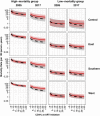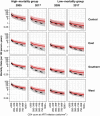Global HIV mortality trends among children on antiretroviral treatment corrected for under-reported deaths: an updated analysis of the International epidemiology Databases to Evaluate AIDS collaboration
- PMID: 34546646
- PMCID: PMC8454681
- DOI: 10.1002/jia2.25780
Global HIV mortality trends among children on antiretroviral treatment corrected for under-reported deaths: an updated analysis of the International epidemiology Databases to Evaluate AIDS collaboration
Abstract
Introduction: The Joint United Nations Programme on HIV/AIDS (UNAIDS) projections of paediatric HIV prevalence and deaths rely on the International epidemiology Databases to Evaluate AIDS (IeDEA) consortium for mortality estimates among children living with HIV (CHIV) receiving antiretroviral therapy (ART). Previous estimates, based on data through 2014, may no longer be accurate due to expanded paediatric HIV care and treatment eligibility, and the possibility of unreported deaths in CHIV considered lost to follow-up (LTFU). We therefore estimated all-cause mortality and its trends in CHIV (<15 years old) on ART using extended and new IeDEA data.
Methods: We analysed (i) IeDEA observational data from CHIV in routine care globally, and (ii) novel data from an IeDEA tracing study that determined outcomes in a sample of CHIV after being LTFU in southern Africa. We included 45,711 CHIV on ART during 2004 to 2017 at 72 programmes in Africa, Asia-Pacific and Latin America. We used mixed effects Poisson regression to estimate mortality by age, sex, CD4 at ART start, time on ART, region and calendar year. For Africa, in an adjusted analysis that accounts for unreported deaths among those LTFU, we first modified the routine data by simulating mortality outcomes within six months after LTFU, based on a Gompertz survival model fitted to the tracing data (n = 221).
Results: Observed mortality rates were 1.8 (95% CI: 1.7 to 1.9) and 9.4 (6.3 to 13.4) deaths per 100 person-years in the routine and tracing data, respectively. We found strong evidence of higher mortality at shorter ART durations, lower CD4 values, and in infancy. Averaging over covariate patterns, the adjusted mortality rate was 54% higher than the unadjusted rate. In unadjusted analyses, mortality reduced by an average 60% and 73% from 2005 to 2017, within and outside of Africa, respectively. In the adjusted analysis for Africa, this temporal reduction was 42%.
Conclusions: Mortality rates among CHIV have decreased substantially over time. However, when accounting for worse outcomes among those LTFU, mortality estimates increased and temporal improvements were slightly reduced, suggesting caution in interpreting analyses based only on programme data. The improved and updated IeDEA estimates on mortality among CHIV on ART support UNAIDS efforts to accurately model global HIV statistics.
Keywords: HIV; antiretroviral therapy; mortality; tracing; trends; under-ascertainment.
© 2021 The Authors. Journal of the International AIDS Society published by John Wiley & Sons Ltd on behalf of the International AIDS Society.
Figures


References
-
- UNAIDS. 90‐90‐90: An Ambitious Treatment Target to Help End the AIDS Epidemic; 2021. [cited 2021 Jan 11]. Available from: https://www.unaids.org/en/resources/documents/2017/90‐90‐90
Publication types
MeSH terms
Substances
Grants and funding
LinkOut - more resources
Full Text Sources
Medical
Research Materials

